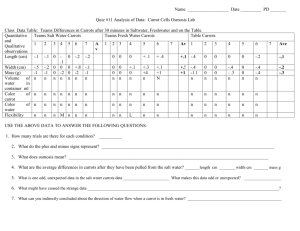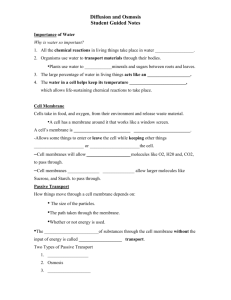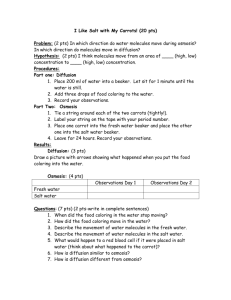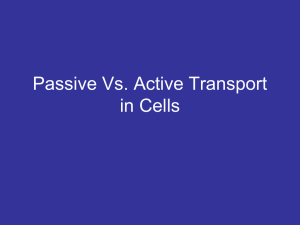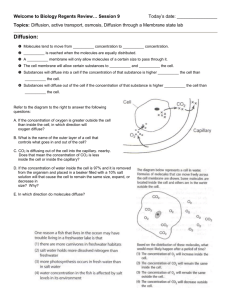File
advertisement
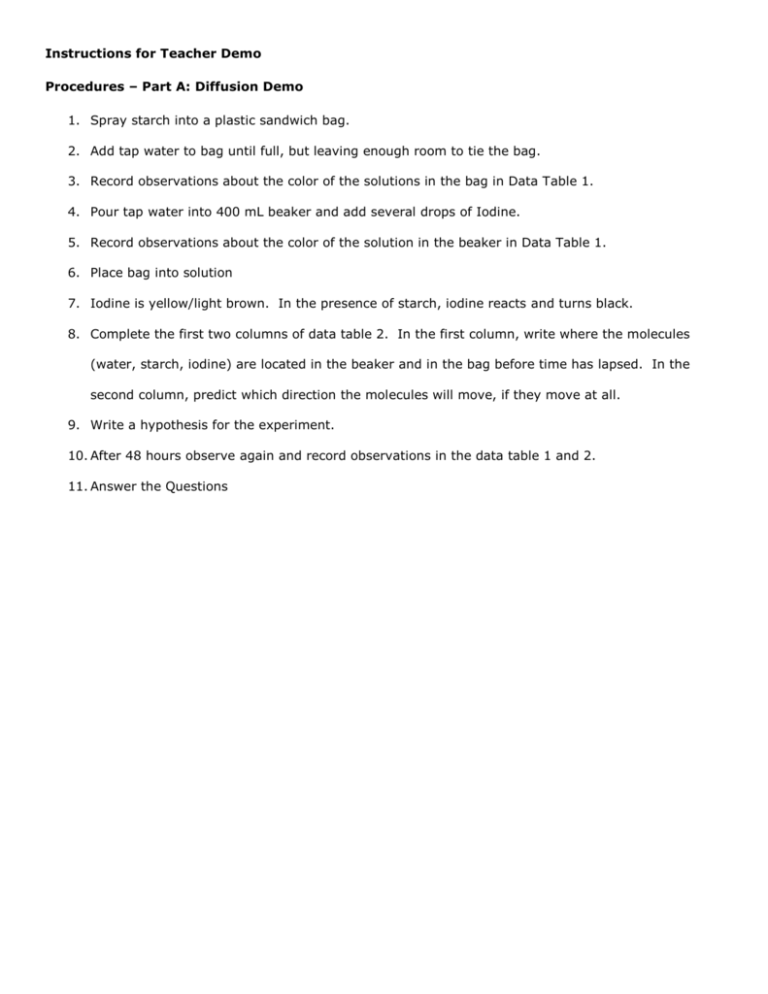
Instructions for Teacher Demo Procedures – Part A: Diffusion Demo 1. Spray starch into a plastic sandwich bag. 2. Add tap water to bag until full, but leaving enough room to tie the bag. 3. Record observations about the color of the solutions in the bag in Data Table 1. 4. Pour tap water into 400 mL beaker and add several drops of Iodine. 5. Record observations about the color of the solution in the beaker in Data Table 1. 6. Place bag into solution 7. Iodine is yellow/light brown. In the presence of starch, iodine reacts and turns black. 8. Complete the first two columns of data table 2. In the first column, write where the molecules (water, starch, iodine) are located in the beaker and in the bag before time has lapsed. In the second column, predict which direction the molecules will move, if they move at all. 9. Write a hypothesis for the experiment. 10. After 48 hours observe again and record observations in the data table 1 and 2. 11. Answer the Questions Lab: Diffusion and Osmosis Objectives 1. Observe diffusion across an artificial membrane. 2. Observe osmosis in plant cells. 3. Measure and observe the changes in the size of the carrot as a result of movement of substances across the membrane's of the carrot cells. Background The cell membrane acts as a barrier to some substances while allowing other substances to enter or leave the cell. When a membrane allows a particular substance to pass through it, it is said to be permeable to that substance. If a membrane allows the passage of some molecules or ions but blocks others, the membrane is semi- or selectively permeable. Cell membranes of living organisms are selectively permeable. The cell membrane acts as a selective barrier between the internal and external environments of the cell. The permeability of the cell membrane can change in response to changes in the cell’s external and internal environments. Some substances, such as water, oxygen, and carbon dioxide, can pass freely through a cell membrane. Other substances have a more limited access to the cell, such as ions and large molecules. In this lab, your teacher will do a demonstration using a sandwich bag as a model for a living cell membrane. Like a living cell, the bag is selective, but unlike living membranes, the bag's selectivity does not vary. That is, there are no protein channels to allow large things to pass through. Only small molecules will pass through the bags’ membrane. In this lab, you will set up conditions to observe osmosis in plant cells. You will make macroscopic observations and infer from those the microscopic changes in the plant cells. Materials 6 plastic cups distilled water 6 baby carrots salt water triple beam balance marker Procedures – Part B: Osmosis Lab You will be placing carrots in distilled water (it is pure water) and salt water. Before performing the experiment, write a hypothesis for each experimental set up. Complete the predictions for data table 3 and 4 to predict which direction water will move with regards to the plant cell, and what the effect will be on the cell for each type of solution. 1. Get materials for group. 2. Label one cup the following: SALT WATER #1 Period Group initials 3. Repeat on two other cups, but using #2 and #3. 4. Repeat on three other cups, but labeling with DISTILLED WATER 5. Use the triple beam balance (see skill sheet) to get the mass of the six carrots, one at a time. Record your data in the Data Table 5. Once you have massed the carrot, put it into one of the labeled cups. 6. Repeat for all six carrots, and calculate the average mass for the three carrots in each solution. 7. Pour the appropriate liquid into each cup until the liquid covers the carrot. 8. Place the cups in the designated area until next class period. 9. After 48h, make macroscopic observations about the carrots, by feeling them. 10. Dry all the carrots very carefully. (You want to make sure that the excess water on the carrot does not affect the final mass measurements.) 11. Measure the final mass for each carrot and record in the Data Table. Calculate the average mass of the carrots for each solution. 12. Calculate the % mass change using the following equation (SHOW YOUR WORK) Initial Mass(g) – Final Mass(g) x 100 Initial Mass (g) **Note: Your results could be a positive % change or negative % change 13. Clean up materials. How to Use a Triple Beam Balance Zeroing screw 1. Before placing the object on the scale, calibrate the scale by sliding all three weight poises (the metal brackets that slide along the three beams) to their leftmost positions. Twist the zeroing screw until the balance pointer lines up with the fixed zero mark. 2. Place the object to be weighed on the center of the pan. When you set an object on the balance platform, the pointer immediately goes up and is no longer zeroed. 3. To find out the weight of the object, slide the weights until the pointer is at zero again. Start with the two heavier weights and then use the lightest one to do the fine tuning. 4. To read the weight of an object in grams, add the number that each weight is at when the pointer is at zero. For example, the heaviest weight above is at 0 grams, the next one is at 10 grams, and then the smallest is at 7.0 grams, then the total weight of the object is 17.0 grams. Name _____________________________________ Date _______________ Per _________ Pre AP Biology Lab: Diffusion and Osmosis Part A – Diffusion Demo Data Table 1 Solution Color of solution at start Color of solution at finish In bag In beaker Data Table 2 Before Prediction on what will happen. What Actually Happened Hypothesis Answer the following questions with a hypothesis. Which molecules, if any, will diffuse across the membrane? How will you know diffusion has occurred? Analysis 1. What molecules diffused across the membrane of the bag? Use data to support your answer. 2. Explain the results you obtained. Include concentration differences and membrane pore size in your discussion. 3. Based on your observations, rank the following by relative size, beginning with the smallest: water molecules, iodine molecules, starch molecules, membrane pores. 4. Evaluate your hypothesis. Part B – Osmosis Lab Data Table 3 – Cells Placed in DISTILLED Water Prediction Actual Show what direction the water Show what Draw what will Draw what will move in the cell direction the water happen to the cell happened to the cell below actually moved below. below. (in or out of the below cell) Hypothesis 2 Answer the following questions with a hypothesis. What will happen to the cells in the DISTILLED water? How will you know that this has happened? Data Table 4 – Cells Placed in SALT Water Prediction Show what direction the water Draw what will will move in the cell happen to the cell below below. (in or out of the cell) Actual Show what direction the water actually moved below Draw what happened to the cell below. Hypothesis 2 Answer the following questions with a hypothesis. What will happen to the cells in the SALT water? How will you know that this has happened? Data Table 5 Salt Water Carrot Distilled Water INITIAL FINAL INITIAL Mass Mass Mass (g) (g) (g) FINAL Mass (g) #1 #2 #3 Average Mass (g) Calculations for %Mass Change Carrots in Salt Water Carrots in Distilled Water Analysis 1. Explain the changes that occurred in the cells of the carrot in salt water, using tonicity terms (hypotonic, isotonic, hypertonic) in your response. 2. Explain the changes that occurred in the cells of the carrot in distilled water, using tonicity terms (hypotonic, isotonic, hypertonic) in your response. 3. Was the carrot in salt water flexible or stiff after 24h? How do you explain this in terms of osmosis? 4. Was the carrot in distilled water flexible or stiff after 24h? How do you explain this in terms of osmosis? 5. In which cup did the carrots increase in cell size? Explain your answer using appropriate vocabulary. 6. In which cup did the carrots decrease in cell size? Explain your answer appropriate vocabulary. Compare and contrast diffusion and osmosis by completing the following Venn diagram. DIFFUSION OSMOSIS 7. If a muscle cell has a high concentration of carbon dioxide molecules and a nearby blood vessel has a lower concentration of carbon dioxide, in which direction will the carbon dioxide move by diffusion? Explain your answer. _____________________________________________________________________________ _____________________________________________________________________________ _____________________________________________________________________________ _____________________________________________________________________________ _____________________________________________________________________________ _____________________________________________________________________________ _____________________________________________________________________________ _____________________________________________________________________________ _____________________________________________________________________________ _____________________________________________________________________________ _____________________________________________________________________________ _____________________________________________________________________________ 8. Most sports drinks are isotonic in relation to human body fluids. Explain why athletes should drink solutions that are isotonic to body fluids whey they exercise rather than ones that are hypotonic to body fluids (contain a greater portion of water in comparison to the fluids in and around human body cells). _____________________________________________________________________________ _____________________________________________________________________________ _____________________________________________________________________________ _____________________________________________________________________________ _____________________________________________________________________________ _____________________________________________________________________________ _____________________________________________________________________________ _____________________________________________________________________________ _____________________________________________________________________________ _____________________________________________________________________________ _____________________________________________________________________________ _____________________________________________________________________________ _____________________________________________________________________________ _____________________________________________________________________________ _____________________________________________________________________________ _____________________________________________________________________________ _____________________________________________________________________________ _____________________________________________________________________________
